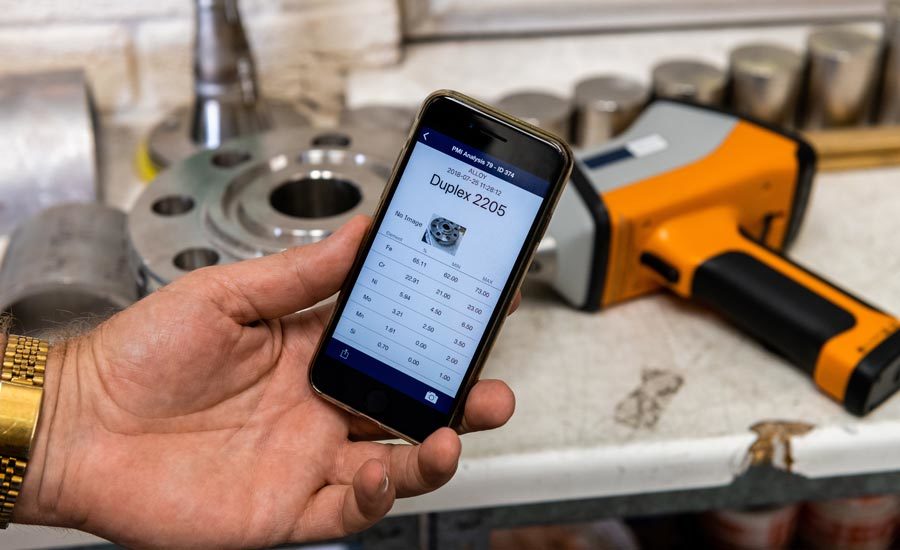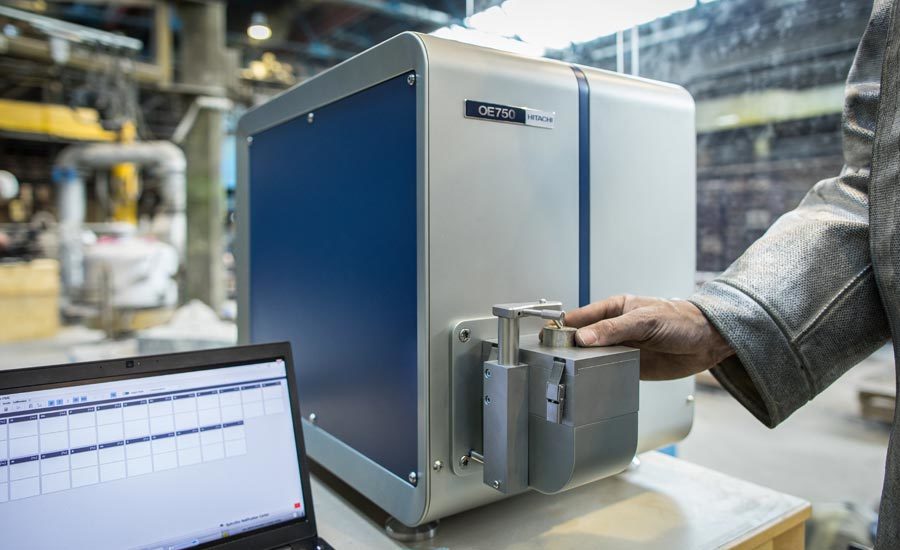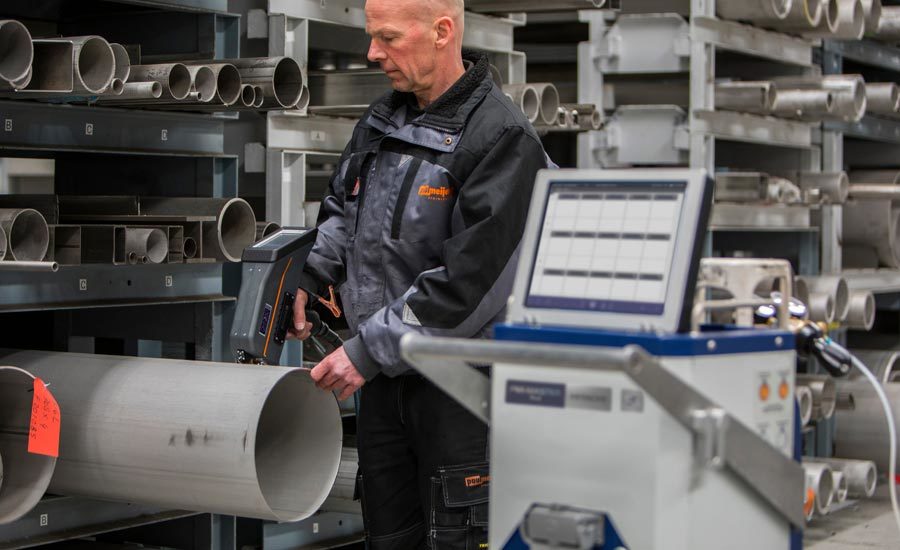When a manufacturing process is completely automated, it is essential to have the right analyzer for each stage of the process.
A lot of people connect Industry 4.0 with digitalization, big data, and smart manufacturing but not as much with PMI (positive material identification) testing. However, in each industrial age we do not lose the key components of the previous revolution, but rather we use new ideas and technology and theory to boost the productivity in our existing manufacturing process. The need for quality control gains even more importance with the introduction of a smart factory and smart production.
When a process is totally automated and integrated into the internet of things (IoT), we are only able to ensure that the right product is manufactured through quality control by showing the elemental composition of incoming and outgoing materials using the most modern and latest spectrometer technology.

ALIGNING YOUR QUALITY PROCESSES TO INDUSTRY 4.0
Industry 4.0 brings intelligence, connectivity, data driving, and automation to individual manufacturing processes with the goal of having a competitive smart factory. Wrapped within Industry 4.0 is the concept of Quality 4.0, which aligns the practice of quality management with the emerging capabilities of Industry 4.0 to help drive organizations toward operational excellence.
A quality system built to Industry 4.0 requirements will measure and send data instantly across its network to enable minor changes to be made in real time within the same production cycle.
Quality 4.0 is an integral part of Industry 4.0 by constructing a quality control process that allows for effortless data driven connectivity. It demands that the technology matches the industry need for instantaneous changes, based on real time data and a proactive approach to manufacturing. This involves the entire supply chain process from incoming material inspection to outgoing material inspection.
IMPORTANCE OF PMI
The issues that are avoided by PMI and elemental analysis techniques are just as relevant as ever in a smart factory. However, quite often when a smart factory and smart production is implemented, very little or no consideration is given to PMI, and quality assurance and control of products. There could be unexpected consequences if a “non-tested” product fails in its application or draws concerns such as identification of the wrong alloy or material delivered by a supplier, supplying end users with the wrong materials, material mix-ups in the warehouse or not knowing if the product has the right elemental composition and desired quality.
The only way to ensure the right product emerges at the end is by checking the elemental composition of incoming and outgoing materials. Ideally at every step of the process where the composition is likely to change. The analytical equipment chosen to integrate with these steps must be in-situ (i.e. not off-site) and be able to give accurate and precise elemental information immediately at each stage. This information must then be transmitted across the network for immediate review and real-time process feedback. PMI analyzers with connectivity, WIFI, ethernet, USB and in the future 4G/5G functionality, can also be taken to the next level by integrating into process control systems and communicating with other machines and resources.
Technologies Explained
XRF provides fast and accurate analysis of all common alloys. With low detection limits and because it’s a totally nondestructive technology, it can also be used for finished goods. A handheld XRF is the most versatile of the three techniques since it is the least sensitive to the surface conditions of a sample and it is not restricted to metal analysis. XRF can provide a thorough chemical analysis consisting of up to 35 elements on a single measurement.
LIBS is the fastest tool for alloy and metal sorting with just one second measurement time. Ideal for checking incoming material and performing checks in the fabrication process. Handheld LIBS is considered the ideal instrument for quick aluminum analysis since, unlike XRF, it can be used to identify lithium in aluminum. A handheld LIBS instrument is the same size as a handheld XRF with the additional benefit of being able to hold a sample in your hand since there is no X-rays.
OES provides the highest level of accuracy and flexibility. The only technique among the three that can provide also high accuracy analysis of carbon, sulfur, phosphorous, boron, tin, arsenic and nitrogen in steels as well as trace elements. Analysis of light elements such as Boron, Sulfur, Carbon, and Phosphorous is integral in determining low alloy steels.

PMI ANALYZER CONNECTIVITY
We are already seeing automation of metals analysis to support stringent quality control programs and metals processing facilities taking advantage of automated sample analysis to measure batches of samples in a single measurement run. In-production analysis integration is also in demand with larger instruments being installed directly into conditioning lines for real-time analysis.
In the future, we are likely to see existing production lines upgraded by adding inline sensors that act as control points for the flow of products from raw material to finished component. This integration of automated checks goes a long way towards capturing potential issues before any time or material is wasted. For example, analytical instruments can push information out to production equipment to start specific tasks such as running analyses or removing a test sample and flag up and halt production when an anomalous result is discovered. This real-time response reduces scrap and rework and helps production react quickly to any issues – essential when budgets are tight.
As we are still probably a few years off from fully integrated, connected and flexible analyzers that feed smart factories with a constant stream of data, learning and adapting based on demands of the production process, having the right material at the right place is and will continue to be hugely important for reducing the cost of poor quality.
CHOOSING THE RIGHT ANALYZER FOR EACH STAGE OF THE PROCESS
The most reliable way to integrate elemental analysis across the manufacturing process is to choose the right technique for the right job. As there is not one ‘right’ technique for the ’right’ job, often companies look for complementary technologies.
X-ray fluorescence (XRF), spark laser induced breakdown spectroscopy (LIBS), and spark optical emission spectroscopy (OES) are the three main technologies used in conjunction with each other to create a suite of complementary technologies for each stage of the production process to ensure right material is in the right place from goods-in to goods-out and every step in between.

For example, nondestructive testing of finished components will need to use XRF technology as that is the only one that leaves the surface completely residue free. Testing to verify that incoming material matches the expected grade can be completed by LIBS or spark-OES technology, as it has been defined in the ASTM 1476. However, for complete metals elemental analysis, including carbon, phosphorous, sulfur, nitrogen, oxygen and hydrogen detection, companies must use spark OES.
When a manufacturing process is completely automated, with little to no human intervention, having the right analyzer for each stage of the process is essential. Complementary material analyzers that are connected will be the key to your success with Quality 4.0.
About the Author :-
Frank Theuws is general manager for global OES distribution of Hitachi High-Tech Analytical Science. With over 30 years of global experience in optical emission spectroscopy, Theuws has a strong understanding of customer needs and future analytical requirements.








